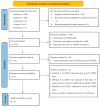Effect of Cochlear Implantation on Air Conduction and Bone Conduction Elicited Vestibular Evoked Myogenic Potentials-A Scoping Review
- PMID: 39598141
- PMCID: PMC11595251
- DOI: 10.3390/jcm13226996
Effect of Cochlear Implantation on Air Conduction and Bone Conduction Elicited Vestibular Evoked Myogenic Potentials-A Scoping Review
Abstract
Background/Objectives: Cochlear implantation (CI) is an effective intervention for individuals with severe to profound hearing loss; however, it may impact vestibular function due to its proximity to related anatomical structures. Vestibular evoked myogenic potentials (VEMPs) assess the function of the saccule and utricle, critical components of the vestibular system. This review examines CI's impact on air conduction (AC) and bone conduction (BC) VEMP responses. Methods: A scoping review was conducted following PRISMA guidelines, using databases such as Medline, Embase, Cochrane Library, Scopus, and ProQuest Dissertations. Studies reporting on AC and/or BC-VEMP in CI recipients were included. Data extraction focused on VEMP response rates, amplitudes, and latencies pre- and post-CI. Risk of bias/quality assessment was performed using the Newcastle-Ottawa Scale. Results: Out of 961 studies identified, 4 met the inclusion criteria, encompassing a total of 245 CI-implanted ears. Results indicated that AC-VEMP responses were often reduced or absent post-CI, reflecting the influence of surgical changes in the middle ear mechanics rather than otolith dysfunction. In contrast, BC-VEMP responses were more consistently preserved, suggesting that BC stimuli bypass the middle ear and more accurately delineate otolith function. Variations in VEMP outcomes were noted depending on the surgical approach and individual patient factors. Conclusions: CI impacts vestibular function as measured by VEMP, with AC-VEMP showing greater susceptibility to postoperative changes compared to BC-VEMP. The presence of preserved BC-VEMP alongside absent AC-VEMP underscores the need to differentiate between these measures in assessing vestibular function.
Keywords: VEMP; bone conduction; cochlear implants; dizziness; electrical stimulation; vestibular evoked myogenic potential; vestibular function.
Conflict of interest statement
The authors declare no conflicts of interest.
Figures
References
Publication types
LinkOut - more resources
Full Text Sources
Miscellaneous


